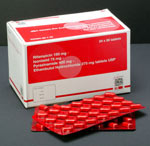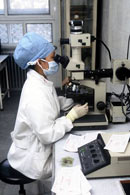



Context - Tuberculosis (TB) is an infectious disease that affects a growing number of people around the world. Usually, it can be treated with antibiotics but some forms of the disease have emerged that do not respond to different types of drugs, making it very difficult to treat, especially in people already infected with HIV.
What are the trends in drug-resistant tuberculosis around the world and what must be done to control it?
This Digest is a faithful summary of the leading scientific consensus report produced in 2008 by the World Health Organization (WHO): "![]()

Tuberculosis (TB) is an infectious disease caused by a bacterium (most commonly Mycobacterium tuberculosis) that mainly affects the lungs.
Many people who are infected with the tuberculosis bacterium will never become ill because the infection is kept under control by their immune system and the infectious tuberculosis bacteria remain dormant. However, if the infection becomes active, the person will become ill and have symptoms such as coughing, weight loss, fever and chest pains. People with a weakened immune system, particularly those who are also infected with HIV, have a greater chance of becoming sick with TB.
When people with active tuberculosis in their lungs cough, sneeze, talk or spit, they propel TB germs into the air, which can contaminate other people who inhale them.
Globally, the proportion of people who become ill with tuberculosis each year is stable or decreasing. However, because of population growth, the absolute number of new TB cases is rising.
Usually, tuberculosis can be treated with antibiotics. However, some forms of the disease have emerged that do not respond to these “first-line drugs”. They are known as multidrug-resistant tuberculosis, or MDR-TB, and can only be cured with a handful of “second-line” drugs which are more expensive and have more adverse effects.
Extensively drug-resistant tuberculosis, or XDR-TB, refers to even more dangerous forms of the disease that are resistant to both first- and second-line drugs and are more difficult to treat. More...

The Global Project on Anti-tuberculosis Drug Resistance Surveillance was launched in 1994 by the World Health Organization (WHO) and other partners to respond to the emerging threat of drug-resistant tuberculosis. The aim of the project is to evaluate drug-resistant tuberculosis, to monitor its progress across the world, and to develop plans to prevent and tackle it.
A network of 26 supra-national reference laboratories supports countries by providing them with drug resistance testing, by giving them technical help, by checking the quality of the tests s performed by the national laboratories and by collecting reliable data. The main priorities for the network are to expand in order to meet the demand for reference laboratories and to obtain regular funding. More...

3.1 Worldwide, between 1 and 1.5 million people are living with multidrug-resistant tuberculosis (MDR-TB). In 2006, there were nearly half a million new cases in the world. More...
3.2 Multidrug-resistant tuberculosis is present in nearly every country in the world but the proportion of MDR-TB among all cases of tuberculosis varies widely from one region to another. For instance, it is lowest in Western and Central Europe, and highest in Eastern Europe.
At present it is not possible to estimate global trends of multidrug-resistant tuberculosis because information from high burden countries is lacking. The available data suggest that different trends exist. For example, MDR-TB is decreasing rapidly in countries such as China and the United States, levelling off in others such as Thailand and Viet Nam, and increasing very rapidly in parts of the former Soviet Union. More...
3.3 It is very difficult to estimate the extent of the problem of extensively drug-resistant tuberculosis (XDR-TB) across the world because few reliable data are available, particularly from the countries with the highest burden of tuberculosis. Still, the problem is widespread, with 45 countries having reported at least one case.
It is a particularly serious problem in countries of the former Soviet Union, where it makes up a very high proportion of the region’s huge number of cases of multidrug-resistant tuberculosis. More...

There is a clear association between tuberculosis and HIV. People infected with dormant tuberculosis bacteria can quickly become sick with tuberculosis when their immune systems are weakened by HIV. Tuberculosis can be very difficult to detect in people who are HIV-positive, which can cause delays in diagnosis. This, together with the difficulty of treating both diseases at the same time, has led to high death rates in people living with TB and HIV.
There are two main reasons why HIV and drug-resistant tuberculosis bacteria may be associated: HIV infection or its treatment could either interfere with anti-tuberculosis drugs and make them less effective, or could lead to resistance to these medicines.
In addition, HIV-infected patients and drug-resistant tuberculosis patients may have similar risk factors such as a shared environment. Indeed, there have been many outbreaks of drug-resistant tuberculosis in places where relatively large numbers of HIV-positive people are in close contact with each other, such as hospitals or prisons. However, information on how tuberculosis is transmitted in these settings cannot be used to predict the spread of drug-resistant tuberculosis among the general population. More...

5.1 In Africa, the level of drug-resistant tuberculosis is low but there could be many undetected cases among HIV-infected people. More...
5.2 In most countries in North and South America only a small proportion of cases of tuberculosis are drug-resistant. In North America, levels of drug-resistant tuberculosis are declining. In South America, Peru, Ecuador and Brazil are the worst affected countries, with Peru alone reporting one third of all new multidrug-resistant cases in 2006. More...
5.3 Although limited, data from the Eastern Mediterranean region indicate moderate levels of multidrug-resistant tuberculosis, with the majority of new cases emerging in Pakistan. More...
5.4 In most countries of Central and Western Europe, there is little resistance to anti-tuberculosis drugs. Some of the countries in Eastern Europe and Central Asia have the highest rates of multidrug-resistant and extensively resistant tuberculosis in the world. In the Russian Federation, the number and the proportion of tuberculosis cases that are drug-resistant are increasing considerably. More...
5.5 South East Asia shows a moderate proportion of drug-resistant tuberculosis cases. However, the number of new cases of tuberculosis in the region is so large, particularly in India, that the overall burden of multidrug-resistant tuberculosis remains considerable. More...
5.6 In the Western Pacific, levels of drug-resistant tuberculosis are moderate. The vast majority of cases were reported in China. Particularly high rates of extensively drug-resistant tuberculosis have been found in Japan and Hong Kong. More...

Collecting reliable information on drug-resistant tuberculosis is expensive, time-consuming and technically complicated. In order to monitor the worldwide spread of drug-resistant tuberculosis over time, it is necessary to test large numbers of samples, and the database of results should include useful information such as the HIV status of the patients, their medical history and other background data. This requires sufficient laboratories to perform drug resistance testing, staff to interview and classify patients and a transport network to send samples for analysis to different laboratories inside and outside the country. These facilities are expensive and not available in many countries, particularly those with the highest burden of tuberculosis.
For practical and economical reasons, current survey methods do not test all cases of TB, which limits the reliability of the results, but nevertheless give a good indication of drug-resistance levels.
To gather more data and determine trends in countries with a high TB burden, surveys must be simplified. New, quicker testing techniques which may help simplify and repeat drug-resistance surveys are currently being developed. More...

7.1 In 2006, approximately half a million new cases of multidrug-resistant tuberculosis (MDR-TB) emerged in the world, with the disease affecting almost every country. The highest proportion of MDR-TB among all TB cases is found in the former Soviet Union. In absolute numbers, the worst affected country is China. More...
7.2 Extensively drug-resistant tuberculosis (XDR-TB) can only be treated with a handful of drugs that are more expensive and have worse side-effects than the drugs used to treat multidrug-resistant tuberculosis. XDR-TB is widespread but is a particularly significant problem in countries of the former Soviet Union, where cases of extensive resistance are high both in absolute numbers and as a proportion of total TB cases. More...
7.3 There is a significant association between HIV and MDR-TB. The death rate in people who have both infections is high. In order to reduce the number of people infected with both HIV and MDR-TB it is important to prevent transmission in places where infected people are in close contact with each other, such as hospitals and prisons. More...
7.4 Despite progress in information gathering, more laboratories and staff are still needed to measure the extent of drug-resistant tuberculosis. The network of supra-national reference laboratories must continue to offer practical help while individual countries improve their facilities. More...
7.5 To control MDR-TB, all countries need to increase their efforts to prevent transmission, detect cases as early as possible and register all patients into a suitable treatment programme. Methods to detect drug resistance quickly and new drugs to treat MDR-TB are urgently needed. More...

This summary is free and ad-free, as is all of our content. You can help us remain free and independant as well as to develop new ways to communicate science by becoming a Patron!